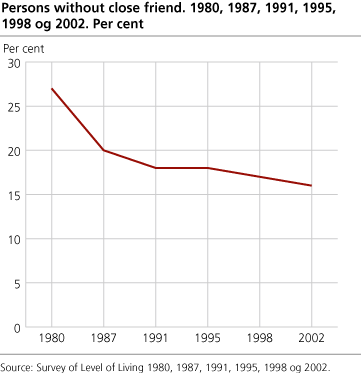Content
Published:
This is an archived release.
We see our friends more than our family
An increasing number of Norwegians have close friends and frequent contact with their family and friends. Despite the fact that more people live alone, almost everyone has someone they can talk to. Nine out of ten think find it easy to get help from their neighbours.
Close friend outside the family
84 percent of Norwegians have a close friend, an increase of 1 per cent since 1998. Viewed in a longer perspective, we see that the number of people with close friends has increased. 27 percent did not have a close friend in 1980, 20 percent in 1987, 18 percent in 1991 and 19951.
More women than men have a close friend. Two out of ten men say that they do not have a close friend, whereas only one out of ten women say the same. There is a correlation between age and intimate friendships. Whereas 33 per cent of people who are 67 years or older do not have a close friend, only 5 per cent of 16 to 24 year-olds say the same.
See friends more often than family
Most people see their parents at least once a month. 23 per cent of Norwegians have little contact with their parents, i.e. they see their parents less than every month2. 15 percent have little contact with their children and 38 percent have little contact with sisters and brothers. These patterns have remained stable from 1998 to 2002. We have not made comparisons further back. However, if we look at contact with the family as a whole, the number of people without or who hardly ever see their close family has remained stable from 12 per cent to 14 per cent from 1980 to 19982.
How often we see our family depends on where we live. Among people in urban areas with
100 000 inhabitants or more, 34 per cent have little contact with their parents. For people living in rural areas the figure is 17 per cent. The same differences apply for contact with children and siblings.
Although most people see their family at least every month, the number of people who see their friends that often is higher. Only 8 percent have little contact with friends, i.e. spend time with good friends less than every month. 92 per cent spend time with good friends every month. The number of people who have little contact with friends has been stable from 1980 until today. In 1980 and 1983 10 per cent said that they had little contact with friends. In 1998 the figure was 9 per cent.
More people live alone
It has become more common to live alone. In 1980, 12 per cent of Norwegians lived alone, in 1995 the figure had increased to 18 per cent and in 2002 the figure was 22 per cent3. The number of people living alone increases with age. Among people aged 67 and over, 46 per cent live alone, while the figure is between 17 and 19 per cent among young people. Because women live longer than men, elderly women are most likely to live alone. More people live alone in urban areas with more than 100 000 inhabitants.
With a little help from our neighbours
Nine out of ten people find it easy to ask their neighbours for help, but people aged 67 or over find it more difficult than others.
1The percentage for 1980 and 1987 is valid for the age group 16 to79 years, while the percentage for 1991, 1995, 1998 and 2002 is valid for the age group 16 years or older.
2 Percentage 16 to 79 years who are without or hardly ever have contact with their close family.
3 The percentage for 1980 is valid for the age group 16 to 79 years, the rest is based on the age group 16 years and older.
Contact
-
Håvard Bergesen Dalen
E-mail: havard.dalen@ssb.no
tel.: (+47) 40 90 23 50



